
Shaolin Hung Mei History
History of Shaolin Hung Mei Kung Fu
Early Shaolin Hung Mei History
Long after the Shaolin Temple was established on Song Shan Mountain, the Temple was ransacked and many of its structures burnt to the ground. Before being rebuilt, a group of the surviving Monks migrated south and constructed a new Temple in the city of Quanzhou, Fujian province. As a result, Shaolin Kung Fu branched into two main styles: Northern and Southern.
Between the time of the end of the Míng (明) Dynasty (~1644 AD) and the fall of the Qīng (清) Dynasty (~1911 AD), there were five established leaders of the southern branch of Shaolin Kung Fu (少林功夫):
Southern Shaolin Temple
- Hung (洪)
- Liú (劉)
- Cai (蔡)
- Lĭ (李)
- Mò (莫)
The Hung (洪) family was further divided into four major groups:
Hung Family
- Hung Jiā (洪家)
- Hung Quán (洪拳)
- Hung Mén (洪門)
- Hung Méi (洪眉)
The first three of these sub-divisions, Hung Jiā, Hung Quán and Hung Mén are Southern Shaolin styles. Our style, Hung Méi, is a Northern branch of the Hung Family.
Our style, Shaolin Hung Méi (少林洪眉), is a traditional form of Chinese Martial Art with roots in the original Shaolin Temple (少林寺). Although we use the name "Shaolin Hung Mei", in reality, our branch of Shaolin Kung Fu owes its origins to both one of the southern branches of the Hung family, Hung Mén ("Door of Hung" - 洪門) as well as to the northern branch, Hung Méi ("Eyebrow or Face of Hung" - 洪眉).

History of our Southern Branch
Tai Shī Fù Kho was originally taught Kung Fu by his Grandfather, Zōng Shī (Grandmaster) Huáng Shŭi Shíng (宗師黃水行). Tai Shī Fù’s Great Grandfather’s name was Huáng Yún Zŭ (黄云祖– Ancestor of the Clouds). Huáng Yún Zŭ was a member of the royal family in the city of Quanzhou, Fujian Province, prior to the revolution of 1911. At some point before the revolution, Huáng Yún Zŭ, concerned with what would happen if the revolution was successful, took his family and moved to Borneo. Huáng Yún Zŭ had three sons: Huáng Shŭi Shíng (黃水行 - Water Star, Mercury), Huáng Yào Xīng (黄耀星 - Sparkling Star), and Huáng Jìng Xīng (黄镜星 - Mirror Star).
Lín Yă Qìng (林亚庆 - 2nd Celebration, Son) was a very well respected Teacher of Southern Shaolin Martial Arts. He spent much of his time traveling around Southeast Asia and, when in Borneo, would often be invited to stay at the home of the Huáng family. As he got older, Lín Yă Qìng decided that he no longer wanted to keep traveling. When Huáng Yún Zŭ heard of Lín Yă Qìng’s desire to settle in one place, he invited the Kung Fu Master to stay at the Huáng home. Although Lín Yă Qìng had not accepted students in the past, he said that he would teach Huáng Yún Zŭ’s sons to repay the kind gesture.
Lín Yă Qìng realized that he was getting older and was concerned that he would not be able to pass all of his knowledge on to the three boys. So, even though all three “grandfathers” (Tai Shī Fù called all three brothers “Grandfather” even though Huáng Shŭi Shíng was his actual blood Grandfather – his Mother’s Father) learned many of the same things, each had a special area of concentration. Huáng Shŭi Shíng, the oldest (Grandfather #1) specialized in weapons, specifically throwing coins. The #2 Grandfather specialized in medicine and the #3, Empty Hand.
Huáng Shŭi Shíng was unfortunately beheaded by the Japanese when they invaded Borneo in the late 1930’s or early 1940’s. It is Tai Shī Fù’s belief that the #2 Grandfather also died in Borneo. However, the #3 Grandfather and the remainder of the family made their way to Jakarta and then to Pekalongon on the island of Java. It was there that the #3 Grandfather taught Kung Fu to young Tai Shī Fù.
Although Tai Shī Fù was actually taught by Grandfather #3, Huáng Jìng Xīng (黄镜星), we maintain the tradition of respecting the eldest of his Grandfathers, Huáng Shŭi Shíng (黃水行), naming him as the family patriarch of our system.
We don’t know too much about Lín Yă Qìng other than knowing that he was a Temple man. We did, however, get a copy of a book concerning Wu Tzu Quan (a group of 5 styles of Kung Fu taught at the Southern Temple throughout the Qing Dynasty) which spoke about a well-known Teacher named Lín Yă Hong. Lín Yă Hong also traveled around Southeast Asia and taught Southern Shaolin at about the same time as Lín Yă Qìng. Furthermore, the book makes reference to a brother of Lín Yă Hong, also a Kung Fu man, but never mentions the brother’s name. We are hoping that we can get more information to confirm that Lín Yă Hong and Lín Yă Qìng were, in fact, brothers, or related in some way, and through that link, uncover more of the Southern branch of our history.
Tai Shī Fù’s Family Tree
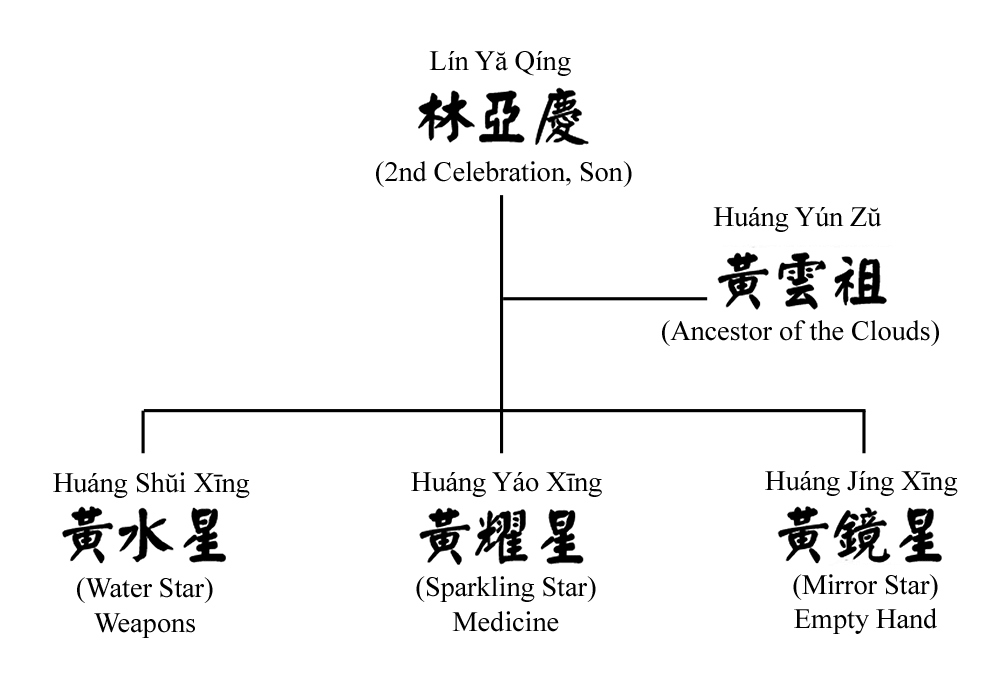
History of our Northern Branch
When Tai Shī Fù’s Grandfather #3, Huáng Jìng Xīng (黄镜星) arrived in Pekalongon, he met and became very close friends with a very well respected Kung Fu Master named Wú Shén Xĭ (宗師吳神禧). As a result of this friendship, the two men shared much of their Kung Fu knowledge.
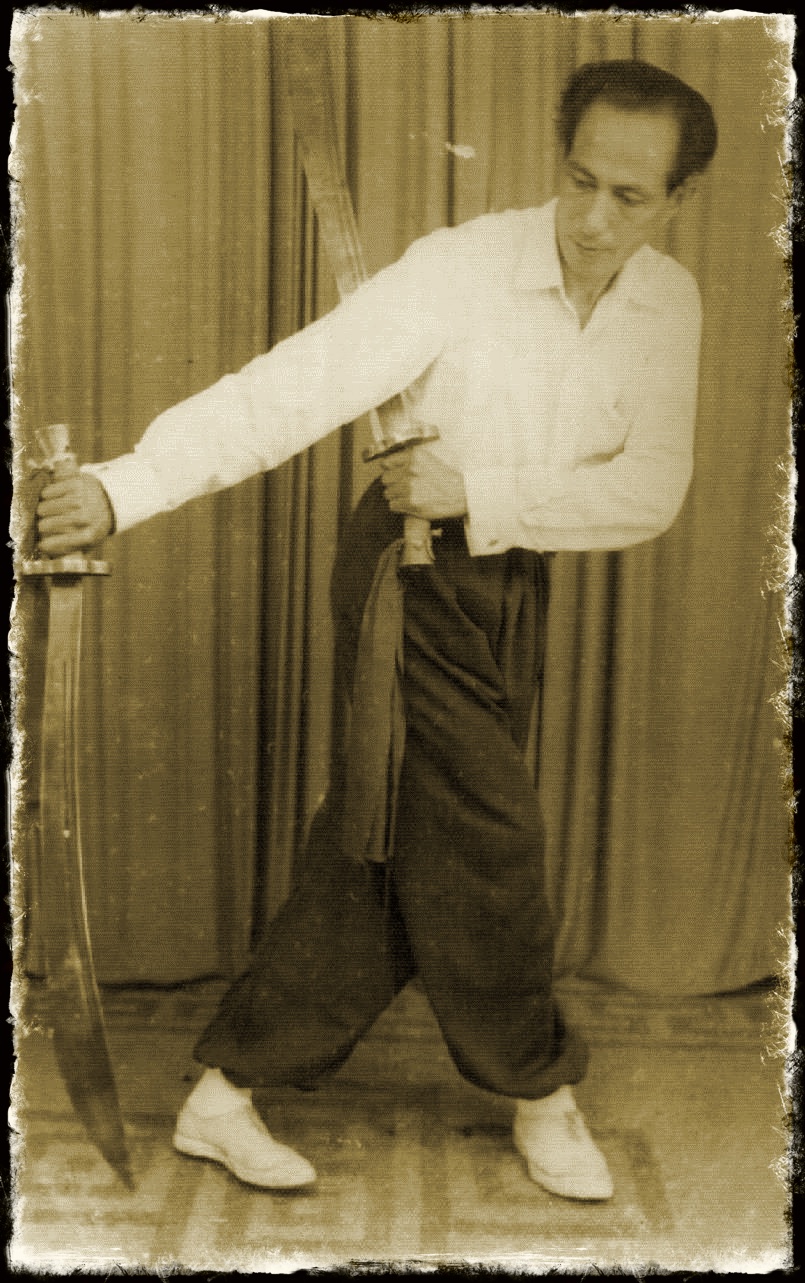 Grandmaster Wú Shén Xĭ (吳神禧) started his Kung Fu training at a young age under the instruction of his mother. His mother had learned Kung Fu from Léi Bái Xíng (雷白行), one of the great Grandmasters of the Hung Méi system. At some point — our investigations point to the early 1940’s — after Zōng Shī Wú Shén Xĭ had learned everything he could from his Mother, he went back to China to find his Mother’s Teacher, Zōng Shī Léi Bái Xíng (宗師雷白行). Unfortunately, we don’t know where Wú Shén Xĭ trained with Léi Bái Xíng, but believe that it could have been Shan Dong Province. Many of our forms (Tao Lu) came from the Shan Dong region so we do have some basis for this assumption. Wú Shén Xĭ (吳神禧) trained under Zōng Shī Xíng for many years and learned the fundamental principles and techniques of Shaolin Temple Kung Fu.
Grandmaster Wú Shén Xĭ (吳神禧) started his Kung Fu training at a young age under the instruction of his mother. His mother had learned Kung Fu from Léi Bái Xíng (雷白行), one of the great Grandmasters of the Hung Méi system. At some point — our investigations point to the early 1940’s — after Zōng Shī Wú Shén Xĭ had learned everything he could from his Mother, he went back to China to find his Mother’s Teacher, Zōng Shī Léi Bái Xíng (宗師雷白行). Unfortunately, we don’t know where Wú Shén Xĭ trained with Léi Bái Xíng, but believe that it could have been Shan Dong Province. Many of our forms (Tao Lu) came from the Shan Dong region so we do have some basis for this assumption. Wú Shén Xĭ (吳神禧) trained under Zōng Shī Xíng for many years and learned the fundamental principles and techniques of Shaolin Temple Kung Fu.
Léi Bái Xíng (雷白行) was a traveling medicine man. He would bring his inventory of herbs and medicines down from his home in
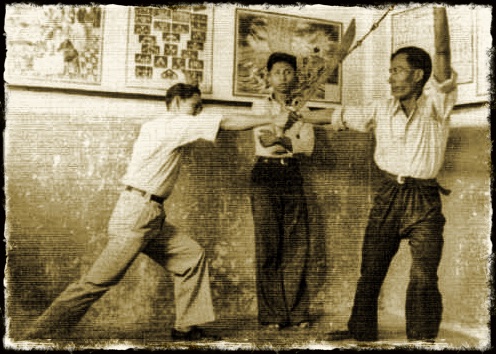 the mountains to the market in town. Wú Shén Xĭ (吳神禧) would carry all of the items on his back. Sometimes, after making the
long journey and after letting Wú Shén Xĭ rest for only a short while, Léi Bái Xíng (雷白行) would simply say, “I don’t think
that there is going to be any business today. Let’s go home.” Wú Shén Xĭ would voice a small protest, arguing that they might
as well try to sell something since they had already made the tiring journey to town. Léi Bái Xíng (雷白行) would respond,
“No, I don’t think there will be any business today. Let’s go.” With that said, Léi Bái Xíng (雷白行) would rise up from where
he was sitting and head up the path toward home. Wú Shén Xĭ (吳神禧) packed up all of their belongings and followed his Master
home for a day filled with Kung Fu instruction. Wú Shén Xĭ (吳神禧) had not realized that the journey itself was part of his training.
the mountains to the market in town. Wú Shén Xĭ (吳神禧) would carry all of the items on his back. Sometimes, after making the
long journey and after letting Wú Shén Xĭ rest for only a short while, Léi Bái Xíng (雷白行) would simply say, “I don’t think
that there is going to be any business today. Let’s go home.” Wú Shén Xĭ would voice a small protest, arguing that they might
as well try to sell something since they had already made the tiring journey to town. Léi Bái Xíng (雷白行) would respond,
“No, I don’t think there will be any business today. Let’s go.” With that said, Léi Bái Xíng (雷白行) would rise up from where
he was sitting and head up the path toward home. Wú Shén Xĭ (吳神禧) packed up all of their belongings and followed his Master
home for a day filled with Kung Fu instruction. Wú Shén Xĭ (吳神禧) had not realized that the journey itself was part of his training.
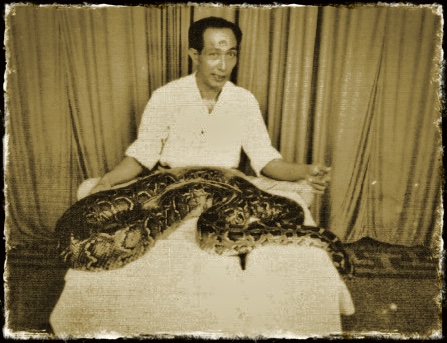 Later, Wú Shén Xĭ (吳神禧) also became a traveling medicine man. Many of the medicines and elixirs that he sold required various parts of poisonous snakes. He became quite proficient in the handling of different species of this reptile.
Later, Wú Shén Xĭ (吳神禧) also became a traveling medicine man. Many of the medicines and elixirs that he sold required various parts of poisonous snakes. He became quite proficient in the handling of different species of this reptile.
In order to sell his medicine, Zōng Shī Wú Shén Xĭ (宗師吳神禧) often performed Kung Fu in front of large crowds. Sometimes the spectators would get too close. To keep them at bay, he would perform his flaming rope dart, whipping and shooting it toward the edges of the crowd. He and his flaming rope dart quickly became quite famous. The townspeople started to call him by the nickname “Ho Fang” (火放), which translates to “throw fire”. Due to the language difference in Indonesia, his name was often pronounced "Hao Peng", and his school referred to as “Hao Peng’s Shaolin Hung Mei Kung Fu”.
 Wú Shén Xĭ (吳神禧) did not just perform his Kung Fu in front of the village market shoppers — he taught his skill to many of the townspeople. His Wŭ Guăn (武館) (martial school) became the strongest in Pekolongan, Indonesia. Every Chinese New Year, Wú Shén Xĭ (吳神禧) and his students were chosen to perform the Lion Dance at the Temple located in the center of town.
Wú Shén Xĭ (吳神禧) did not just perform his Kung Fu in front of the village market shoppers — he taught his skill to many of the townspeople. His Wŭ Guăn (武館) (martial school) became the strongest in Pekolongan, Indonesia. Every Chinese New Year, Wú Shén Xĭ (吳神禧) and his students were chosen to perform the Lion Dance at the Temple located in the center of town.
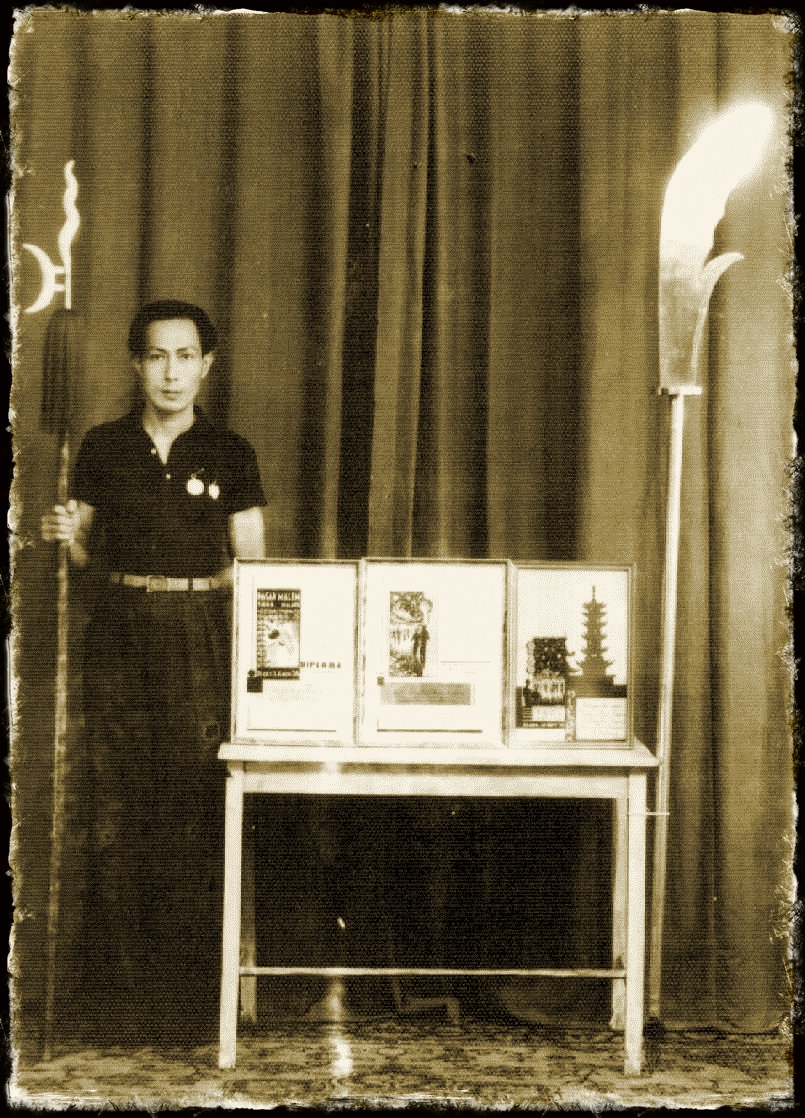 Zōng Shī Wú demonstrated his Kung Fu at the National Kung Fu Tournament held in Indonesia. This tournament was considered to be very prestigious as it was held only every twenty-five years and martial artists from many countries traveled to Indonesia to participate. Wú Shén Xĭ (吳神禧) was among the most successful of all of the competitors.
Zōng Shī Wú demonstrated his Kung Fu at the National Kung Fu Tournament held in Indonesia. This tournament was considered to be very prestigious as it was held only every twenty-five years and martial artists from many countries traveled to Indonesia to participate. Wú Shén Xĭ (吳神禧) was among the most successful of all of the competitors.
As a result of the friendship between the Wú Shén Xĭ and Tai Shī Fù’s Grandfather #3, Huáng Jìng Xīng (黄镜星), Zōng Shī Wú became Tai Shī Fù’s Teacher after Huáng Jìng Xīng (黄镜星) left Pekalongon. Tai Shī Fù trained with Wú Shén Xĭ until he left Indonesia and immigrated to the United States.
During his years of teaching, Zōng Shī Wú Shén Xĭ (宗師吳神禧) successfully passed down the principles and values of Shaolin (少林) to many students. Tai Shī Fù Tonny Kho (太師父許敬唐) has been particularly diligent in continuing to teach these traditions, and brought the style of Hung Mei (洪眉派) to the United States in 1968.
In traditional Chinese culture, a true student of Kung Fu has only one Shifu. While he may learn techniques and methods from other Teachers, he only refers to the one Teacher as his “Shifu”. At the wish of Tai Shī Fù’s Grandfather, we identify Zōng Shī Wú Shén Xĭ (宗師吳神禧) as the Grandmaster of our system although we also recognize the knowledge and skills passed down through Grandfather Huáng Jìng Xīng’s (黄镜星) teachings.
Recent Shaolin Hung Mei History
Tai Shī Fù Tonny Kho (太師父許敬唐)
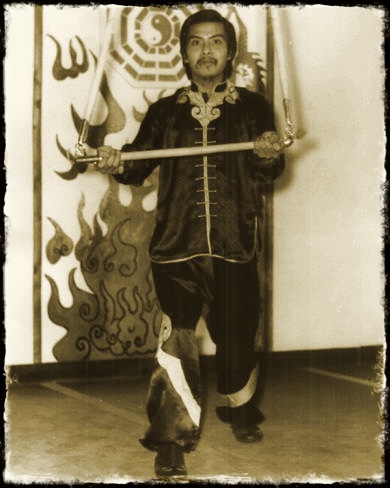 Although Tai Shī Fù Tonny Kho (太師父許敬唐) actually began his martial arts training under the instruction of his Grandfather #3, Huáng Jìng Xīng (黄镜星), he adheres to tradition and recognizes his eldest Grandfather, Huáng Shŭi Shíng (黃水行), as his first Teacher. He spent his entire first year, at the early age of five, training only the basic stances of the Shaolin (少林) system. Several years later, when Zōng Shī Huáng Jìng Xīng (宗師黄镜星) moved from their hometown, he asked his close friend, Wú Shén Xĭ (吳神禧), to continue his grandson’s martial education.
Although Tai Shī Fù Tonny Kho (太師父許敬唐) actually began his martial arts training under the instruction of his Grandfather #3, Huáng Jìng Xīng (黄镜星), he adheres to tradition and recognizes his eldest Grandfather, Huáng Shŭi Shíng (黃水行), as his first Teacher. He spent his entire first year, at the early age of five, training only the basic stances of the Shaolin (少林) system. Several years later, when Zōng Shī Huáng Jìng Xīng (宗師黄镜星) moved from their hometown, he asked his close friend, Wú Shén Xĭ (吳神禧), to continue his grandson’s martial education.
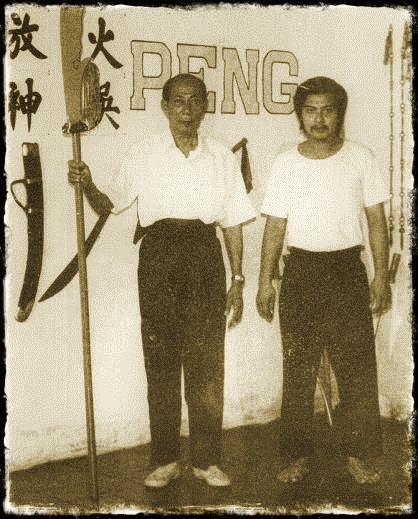 Tai Shī Fù Kho (許太師父) practiced religiously under the direction of Wú Shén Xĭ (吳神禧). Over the years, he became proficient in the Shaolin (少林) style known as Hung Méi (洪眉). Eventually, he began to help train the younger students and received the title of “Shī Fù” (師父) in 1962.
Tai Shī Fù Kho (許太師父) practiced religiously under the direction of Wú Shén Xĭ (吳神禧). Over the years, he became proficient in the Shaolin (少林) style known as Hung Méi (洪眉). Eventually, he began to help train the younger students and received the title of “Shī Fù” (師父) in 1962.
Kung Fu (功夫) was not a hobby or a sport for the Chinese population in Indonesia — it was a means of self-defense necessary in a place of political turmoil. Unlike the United States, a fight in the streets of Indonesia did not end in a court settlement.
The political instability of Indonesia was the driving force for Tai Shī Fù’s emigration. With his mother’s financial support, he came to the United States in 1968. When he arrived, his Chinese name, Xú Jìng Táng (許敬唐), was changed to Tonny Kho (許敬唐), and he started a new life in his new home. His aunt brought him to Long Island, New York, where he enrolled as a student at Stony Brook University.
To help pay for his education, Tai Shī Fù Kho (許太師父) worked part-time in a friend’s restaurant. During this time, he lived in a loft above the restaurant with seven other people. Despite these living conditions and the fact that he was miles from his home, Tai Shī Fù (太師父) was able to successfully earn a Linguistics degree from Stony Brook University.
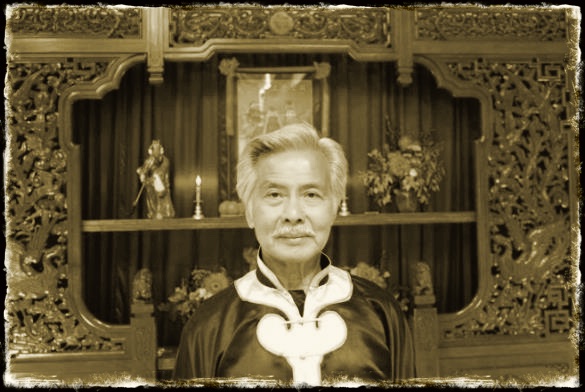 Tai Shī Fù Kho (許太師父) continued his martial arts training, eventually opening his own Kung Fu school in Islip, New York. Since that time, he has received an MBA with Honors from Dowling College and established a successful lawn irrigation business, both while working for the Suffolk County Water Authority. His Kung Fu organization has continued to grow and now boasts a branch of Hung Méi in Boulder, Colorado.“Shī Fù” (師父) translates to “knowledgeable Father”. With his caring, yet stern, nature and continued dedication, Tai Shī Fù Kho (許太師父) exemplifies the meaning of the words “Shī Fù” (師父).
Tai Shī Fù Kho (許太師父) continued his martial arts training, eventually opening his own Kung Fu school in Islip, New York. Since that time, he has received an MBA with Honors from Dowling College and established a successful lawn irrigation business, both while working for the Suffolk County Water Authority. His Kung Fu organization has continued to grow and now boasts a branch of Hung Méi in Boulder, Colorado.“Shī Fù” (師父) translates to “knowledgeable Father”. With his caring, yet stern, nature and continued dedication, Tai Shī Fù Kho (許太師父) exemplifies the meaning of the words “Shī Fù” (師父).
Founding of Shaolin Hung Mei in the United States
When Tai Shī Fù Tonny Kho (太師父許敬唐) first arrived in the United States, he taught his Kung Fu to a few of his classmates at Stony Brook University in New York. However, during those undergraduate years, he needed a place where he could practice steadily. He had visited a Karate school, Jerome Mackie’s, where he was allowed to continue to train. Impressed with his skill, the school’s Director soon recruited Tai Shī Fù Kho. He was added to the staff as a teacher of Chinese Kung Fu.
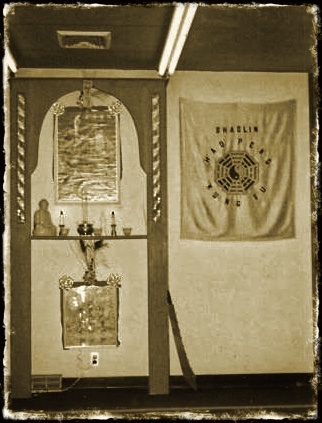 In 1973, Tai Shī Fù (太師父) opened his own Wŭ Guăn (武館) (martial school) in Islip, Long Island. A strong base of dedicated students gathered. Shortly, several major purchases of equipment, including the area’s first eighty-five foot long Dragon, were made. In addition, the School became an active member of the Chief Eastern United States Kung Fu Federation and gained recognition for sponsoring three major Kung Fu exhibitions at Hofstra University and Islip Town Hall.
In 1973, Tai Shī Fù (太師父) opened his own Wŭ Guăn (武館) (martial school) in Islip, Long Island. A strong base of dedicated students gathered. Shortly, several major purchases of equipment, including the area’s first eighty-five foot long Dragon, were made. In addition, the School became an active member of the Chief Eastern United States Kung Fu Federation and gained recognition for sponsoring three major Kung Fu exhibitions at Hofstra University and Islip Town Hall.
 A branch of the organization was established at the Chinese Community Center in Hempstead, New York. Shaolin Hung Méi had gained the respect of the Chinese and martial arts communities and was recognized as a true school of traditional Kung Fu.
A branch of the organization was established at the Chinese Community Center in Hempstead, New York. Shaolin Hung Méi had gained the respect of the Chinese and martial arts communities and was recognized as a true school of traditional Kung Fu.
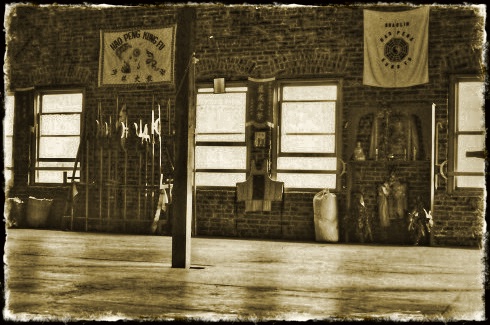 By 1976, the School had relocated to Bayshore, New York. In February of that year, Tai Shī Fù Kho and his students began the annual tradition of “bai nián” (拜年) for the Chinese New Year. The members would perform Lion Dance for many of the local merchants and welcome the New Year with good luck and good fortune. The “hóng bāo” (紅包) (red envelope), or gifts of thanks given to the Lion performers, enabled the School to purchase its needed supplies. More importantly, the performance of the Lion Dance provided the students important lessons in culture and enhanced the sense of “family” that had been developed by Tai Shī Fù Kho (許太師父).
By 1976, the School had relocated to Bayshore, New York. In February of that year, Tai Shī Fù Kho and his students began the annual tradition of “bai nián” (拜年) for the Chinese New Year. The members would perform Lion Dance for many of the local merchants and welcome the New Year with good luck and good fortune. The “hóng bāo” (紅包) (red envelope), or gifts of thanks given to the Lion performers, enabled the School to purchase its needed supplies. More importantly, the performance of the Lion Dance provided the students important lessons in culture and enhanced the sense of “family” that had been developed by Tai Shī Fù Kho (許太師父).
Tai Shī Fù (太師父) soon realized that maintaining a martial arts school in the United States required making
sacrifices to sustain the “business”. He became concerned over the possible dilution of what he had accomplished.
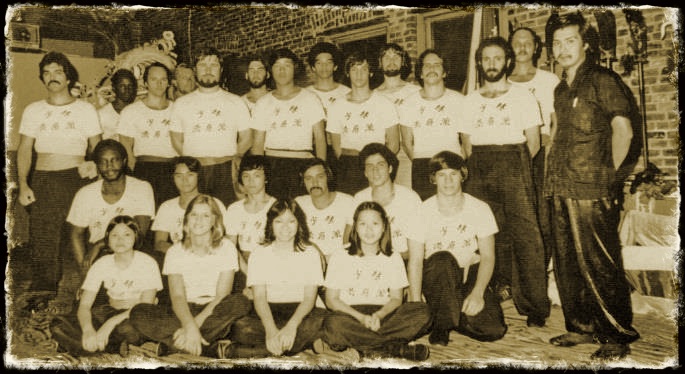 As a result, he “closed the doors” of the School and began to train only his most dedicated students in the privacy of his home. Here, he was able to teach his art without compromise. He kept the roster small and was able to tightly control the quality of Hung Méi’s members. Universal recognition of the martial and Lion Dancing skills as well as the school’s adherence to Chinese culture, history, philosophy and theory, followed.
As a result, he “closed the doors” of the School and began to train only his most dedicated students in the privacy of his home. Here, he was able to teach his art without compromise. He kept the roster small and was able to tightly control the quality of Hung Méi’s members. Universal recognition of the martial and Lion Dancing skills as well as the school’s adherence to Chinese culture, history, philosophy and theory, followed.
Hung Méi (洪眉) continued to receive frequent requests for Kung Fu, Lion Dance and Dragon performances. The small group was honored to have been asked to appear at such venues as the numerous Dragon Boat Festivals sponsored by the Hong Kong Economic and Trade Office of the British Consulate and the Trump Taj Mahal. In addition, the students successfully competed in both Chinese style and open martial arts tournaments. By 1991, Hung Méi had established strong ties with the community and soon after was appointed a permanent member of the Board of Directors of the newly formed United Kung Fu Federation of North America. Later that year, the School once again opened its doors to the general public by establishing a center in Oakdale, New York. In early 1993, a senior student, Shī Fù H. Solow founded Hung Méi in Colorado. A few years later, Shī Fù Larry Sweeney and Shī Fù Frank Mattera, two of Tai Shī Fù’s most senior students, opened a branch of Hung Méi in Deer Park, New York. In addition to these Shī Fù, the Organization has grown to include Shī Fù Jim Lantier, Shī Fù Jim Mascarelli, Shī Fù Rob Mascarelli, Shī Fù Rama Kho (Tai Shī Fù’s son), Shī Fù James Chan, Shī Fù Simon Chan, Shī Fù Thomas Clark, Shī Fù Scott Solow, Shī Fù Carolyn Chin and Shī Fù Gordon Yee.
The skills, knowledge and culture of Shaolin Hung Méi are very much alive. Following the example and leadership of Tai Shī Fù Kho, several of these Teachers continue to pass on this valuable art to new generations.
Founding of Shaolin Hung Mei in Colorado
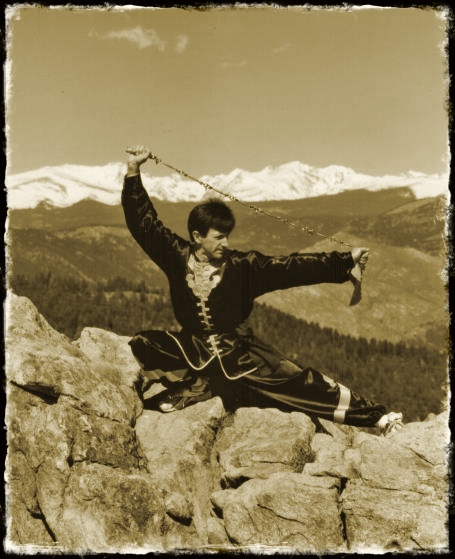 Early in 1992, Shī Fù H. Solow (師父許浩義) relocated from Long Island, New York to Boulder, Colorado. He had been living in Boulder for just less than one year when Lance Melting and Jason Lathrop, both of whom had frequently watched Shī Fù Solow practice, asked to become students. Finally, in February of 1993, the Colorado branch of Shaolin Hung Méi was founded.
Early in 1992, Shī Fù H. Solow (師父許浩義) relocated from Long Island, New York to Boulder, Colorado. He had been living in Boulder for just less than one year when Lance Melting and Jason Lathrop, both of whom had frequently watched Shī Fù Solow practice, asked to become students. Finally, in February of 1993, the Colorado branch of Shaolin Hung Méi was founded.
Several others soon joined the group and arrangements were made with the East Boulder Community Center for workout space. In order to maintain the high standards of tradition, culture, history and technique taught to him by Tai Shī Fù Kho, Mr. Solow decided not to advertise but to hand select new students.
By the end of the first quarter of 1995, the Wŭ Guăn (武館) conducted its first “Test for Rank”, purchased a complete compliment of traditional weaponry, purchased its first Lion and performed Lion Dance and Kung Fu for the Chinese New Year, State Legislature and Organization of Chinese Americans. Because of the solid foundation taught to Shī Fù Solow by Tai Shī Fù Kho, the small School was very well received and it quickly established strong relationships with many of the greater Boulder/Denver area Chinese organizations.
The group of students developed a powerful sense of “family”. Everyone helped make the tools needed by the organization: ten-foot-long, pennant style banners with hand cut and sewn characters, a portable drum stand used for parading when performing the Lion, a weapons rack and others. It was only through these efforts that the School was able to grow.
By Chinese New Year 1996, Shaolin Hung Méi, Colorado had received its second Lion and was again celebrating with many of the Chinese organizations and restaurants in Denver/Boulder. In April, several of the students competed in open tournament for the first time. Their success was very motivating for the entire association. In November, the School was honored with the request to open the fabulous Imperial Tombs Exhibit sponsored by the Chinese government and presented at the Denver Museum of Natural History. The Governor of Colorado, Roy Romer; Denver Mayor, Wellington Webb; and the Chinese Ambassador to the United States, Ambassador Li, attended the event. Most importantly, Tai Shī Fù Kho (許師父) made his first trip to Colorado to visit the students.
1997 was a pivotal year for Shaolin Hung Méi Colorado. The School had its biggest Chinese New Year ever. The recognition
and acceptance that it received was very exciting. By that time, the Organization’s New Year’s performances had become
 an anticipated annual event for many in the Chinese community.
On February 16th of that year, Hung Méi in Colorado opened its doors to six to twelve year old children. Almost all of these new students were Chinese. Shī Fù Solow felt very honored by the trust granted him by the parents of the children and gave credit to the way in which he was taught by Tai Shī Fù Kho (許太師父).
an anticipated annual event for many in the Chinese community.
On February 16th of that year, Hung Méi in Colorado opened its doors to six to twelve year old children. Almost all of these new students were Chinese. Shī Fù Solow felt very honored by the trust granted him by the parents of the children and gave credit to the way in which he was taught by Tai Shī Fù Kho (許太師父).
Many performances and tournaments followed. The students continued to demonstrate appreciable dedication in studying the many aspects of Shaolin Hung Méi. In July, Tai Shī Fù Kho’s son, Rama Kho, (師父許子誠) relocated to Boulder to help the Colorado branch grow. Another milestone was reached in September when the group received its nine man Dragon. They had the opportunity to perform the Dragon — the only one in the state of Colorado — twice that year.
By the beginning of 1998, in only its fifth year, Shaolin Hung Méi Colorado had grown to almost 50 members and had a dedicated following of the parents of the Chinese children. It had developed solid relationships with virtually every Chinese organization in the Denver/Boulder area, had performed up to six Lions and had competed very successfully in open tournament. Most importantly, the School had developed a strong core of committed students who invested the effort needed to build such an organization. Even with all of their success in these supportive activities, they knew that their core purpose was the learning and understanding of the teachings, history, philosophies, culture and techniques of the traditional art of Shaolin Hung Méi Kung Fu. They greatly appreciated Tai Shī Fù Kho’s passing on the knowledge of the Shaolin Martial Arts.
